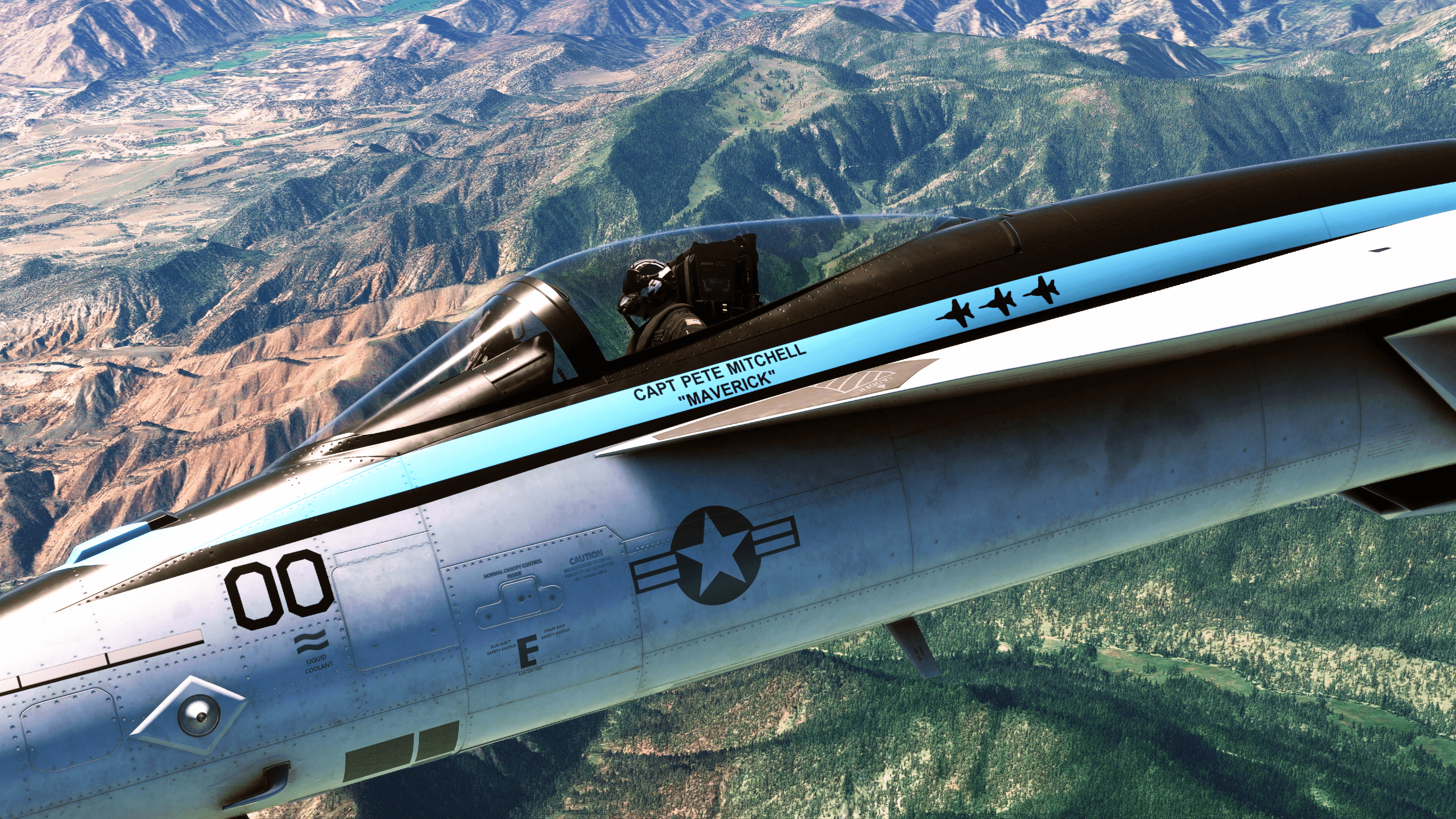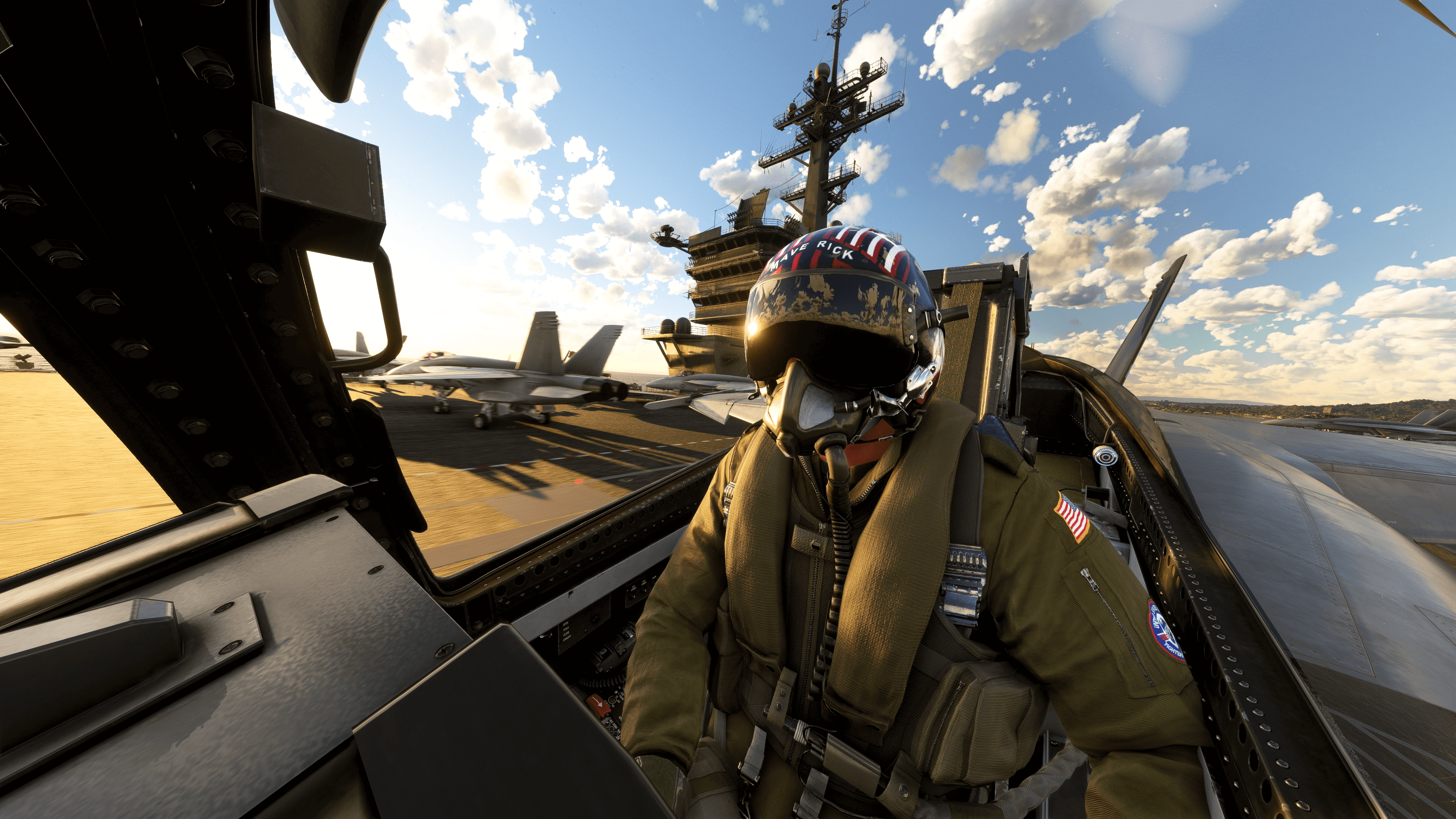In a wide-ranging chat with Microsoft Flight Simulator boss Jorg Neumann, VG247 decided to check in on how, six months later, the unprecedented move to add the Dropship 77 Troop Carrier aka the D77-TC, aka the ‘Pelican’, has been received by the fanbase. The answer is perhaps just as surprising - it hasn’t just been well-received, but so well received that the Flight Sim team will offer similar content in the future.
The Halo tie-in wasn’t this new version of Flight Simulator’s first crossover of course - with the huge Game Pass success first featuring an add-on pack to celebrate the release of Top Gun Maverick in theaters. In many ways, it’s with Top Gun that this story begins.
“Top Gun I felt very safe with, because our team is pretty diverse between core simmers and gamers… but the core simmers loved it,” Neumann says. “There’s not a person that said, ‘Top Gun, are you serious?’ Everybody was like, oh, that’s awesome.”
Part of the reason, Neumann notes, is the jigsaw-perfect fit between the Top Gun and Flight Simulator brands. The ‘fighter pilot guy’ on the Flight Sim team, it’s noted, joined the navy because he watched Top Gun. The shared DNA is significant. For Halo, the equation isn’t anywhere near as simple.
“Top Gun wasn’t even a consideration. The Pelican was risky in a way,” Neumann admits.
So, months on, and as Flight Simulator enjoys high-profile 40th anniversary celebrations, how did it go? “It was very positive,” says Neumann.
“The Halo guys loved it. So the Halo audience, look - they ate it up. And the flight simmers were not as annoyed as I thought they might be,” Neumann laughs. “And mostly because we didn’t half-ass the aircraft.
“As a matter of fact, well, we asked the Halo team - ‘how does this thing work?’ And they’re like… ‘um just come up with stuff - like aviation stuff’. So we invented a bunch of stuff - but it all makes sense. So we actually ran that by the hardcore simmers all over the place saying - okay, here’s the avionics package, here’s the radar, here’s how this thing will work - and they all liked it. So it’s an actual believable aircraft now.”
This differs significantly from the Top Gun content, where because the film used real aircraft, military-led aerospace company Lockheed Martin sent over employees, including simulation fans, to help the developers. With Halo, the Flight Simulator team had relatively free reign to decide how this unique and iconic ship would fly in a realistic manner - which is sort of where the magic happened that allowed it to be a worthwhile addition for both fans who just want to zip the Pelican around the world, and simulation fanatics who are just excited to learn a new aircraft - even if it isn’t real.
The success of the Pelican has also inspired some decisions about future content and adjustments to Microsoft Flight Simulator - as Neumann explains.
“I think the only time I was getting a little bit nervous was right around launch when the entirety of New York was - literally, if you were in the sim, look up in New York and there were thousands upon thousands of Pelicans - and the Simmers’ reaction was like… ‘hmmm… it’s a little much’,” Neumann laughs.
“So they weren’t angry-angry, but it’s like, I think we tested their resolve a little bit, they were right at the edge.
“At which point I said, y’know, there needs to honestly be some mode that he can click on. If you want to have real, reality mode that is only planes that fly today, you need to be able to click that, and then some of these other things shouldn’t be allowed. It’s not a private lobby, right? But it’s a shared world which has a logic. Then if you want to allow everything, allow everything.”
A system like this is in the grand plan for the future of Flight Simulator, which stretches many years into the future thanks to the break-out success of this Game Pass powered reboot. Another part of this roadmap, Neumann confirms, is more content in the vein of the Top Gun and Halo updates.
“Yes; there will be more of those sorts of things,” Neumann makes clear – though this will always form part of a greater package. Updates that feature real-world aircraft will always be a key priority, and the development team is constantly digitally scanning and appraising aircraft for future inclusion. At the same time, however, after the success of Top Gun, Hollywood is coming knocking.
“I mean, the thing that probably maybe doesn’t get talked about that much is the Paramount relationship – which was awesome,” Neumann reveals, referring to the movie studio behind the Top Gun franchise.
“So Paramount hooked us up with Lockheed, we worked with Lockheed. We immediately click with the Lockheed guys because they’re actually simmers, so they actually care about aviation. And the Paramount guys are running around the world saying this was the most positive gaming integration of all times for them – and they’re running around Hollywood saying that.
“At which point I get calls from Hollywood. Like, ‘Hey Jorg! We have this thing!’ I’m like, it’s at the fringes of what you’d call aviation… I dunno… maybe?”
So. not everything will make it in. But at this 40th anniversary event, Flight Simulator is presented through multiple lenses - as a simulator, as a learning tool, as digital exploration, and as a celebration of the joy of flight in general. That last one, and flight’s cultural importance, is practically inextricable from how flight is presented in other forms of media – including fictional aircraft.
“I think we at least have a good reputation because it’s the same care, right?” Neumann says, referring to how even fictional or film tie-ins get the same microscopic level of attention-to-detail as simulating a real vehicle to a fit-for-training standard. “We don’t half-ass, we didn’t half-assthe thing.”
So… Avengers Quinjet, anyone?


